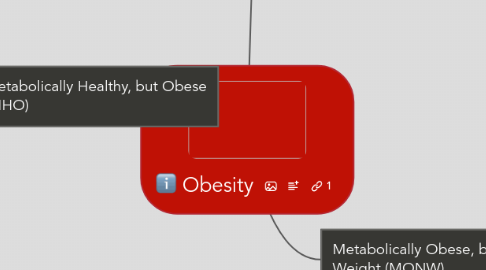
1. Metabolically Healthy, but Obese (MHO)
1.1. profile
1.1.1. large quantities of fat mass
1.1.2. normal - high levels of insulin sensitivity
1.1.3. favorable cardiovascular risk profiles
1.1.4. chrasteristics
1.1.4.1. low visceral fat
1.1.4.2. high body mass index
1.1.4.3. high fat mass
1.1.4.4. high insulin sensitivity
1.1.4.5. high HDL
1.1.4.6. low triglycerides
1.2. Population
1.2.1. 20%
1.2.2. Women
1.2.2.1. more favorable lipid profile evidenced by
1.2.2.1.1. lower fasting triglycerids
1.2.2.1.2. high HDL
1.2.2.1.3. lower fasting glucose and insulin concentrations
1.3. Variables
1.3.1. amount of visceral fats associated with variations in insulin sensitivity
1.3.2. an earlier start(<20 years) of obesity associated with a more favorable metabolic profile (Brochu)
1.3.2.1. Muscelli
1.3.2.1.1. + association between duration of obesity and insulin sensitivity
1.3.2.1.2. explanation
1.4. Researchers
1.4.1. NOT find
1.4.1.1. differences in resting metabolic rate and physical activity energy expenditure
1.4.2. Even in high levels of body fat, lower levels of visceral fat confer metabolic advantages
1.4.2.1. obese or nonobese Japanese
1.4.2.2. normal visceral fat area
1.4.2.2.1. decrease obesity's risk factors
1.4.3. Lamarche
1.4.3.1. visceral fat accumulation >130 cm3
1.4.3.1.1. associated decrease insulin sensitivity
1.4.4. Matsuzawa
1.4.4.1. Japanese Sumo wrestlers
1.4.4.1.1. "metabolically healthy"
1.4.4.1.2. However
1.5. Risks
1.5.1. MHO lower risks than obese, but higher risk than general population
1.5.2. +visceral fat, - insulin sensitivity , + cacrdiovascular disease
1.5.3. larger adipocytes, increase insulin resistance
1.5.4. normal size adipocytes, onset of obesity
2. Introduction
2.1. Objective
2.1.1. therapeutic decision making
2.1.2. medical education
2.1.2.1. useful in guiding
2.1.2.1.1. primary and secondary prevention
2.1.3. characterization of subjects in research protocols
2.1.4. examine
2.1.4.1. roles of metabolic
2.1.4.2. body composition
2.1.4.3. cardiovascular disease risk
2.2. Subtypes
2.2.1. Metabolically healthy, but obese (MHO)
2.2.1.1. due to
2.2.1.1.1. lower visceral fat levels
2.2.1.1.2. earlier start of obesity
2.2.1.2. profile
2.2.1.2.1. normal to high levels of insulin sensitive
2.2.1.2.2. normal metabolic profile
2.2.2. Metabolically Obese, but normal wight(MONW)
2.2.2.1. due to
2.2.2.1.1. higher fat mass
2.2.2.1.2. higher plasma triglycerids
2.2.2.1.3. higher visceral fat and liver content
2.2.2.2. profile
2.2.2.2.1. normal body mass index
2.2.2.2.2. risk factors
3. Metabolically Obese, but Normal Weight (MONW)
3.1. Profile
3.1.1. High Visceral Fat
3.1.2. Low body mass index
3.1.3. High fat mass
3.1.4. Low lean body mass
3.1.5. Low insulin sensitivity
3.1.6. High liver fat
3.1.7. High triglycerides
3.2. Charasteristics
3.2.1. Young people
3.2.2. Display premature signs of
3.2.2.1. insuline resistance
3.2.2.2. hyperinsuilnemia
3.2.2.3. dyslipidemia
3.2.3. Increase diseases
3.2.3.1. diabetes
3.2.3.2. could go undetected for years
3.2.3.2.1. due to
3.2.3.3. cardiovascular disease
3.3. Suggestions
3.3.1. body composition and body fat
3.3.1.1. play a role in development of metabolic complications
3.3.2. high prevalence in general population (20)
3.3.3. Physical daily energy expenditure appears to influence insulin sensitivity and cardiovascular risk factors
3.3.4. Low levels of physical activity energy expenditure could favor a positive balance
3.3.5. Higher fat mass women could be mediated indirectly by low cardio fitness
3.3.6. Excessive fat on upper part or abdomen -> risk diabetes and cardio diseases
3.3.7. Increase liver fat-> decrease insulin sensitivity
3.4. Studies
3.4.1. Zavaroni
3.4.1.1. higher plasma triglycerides and lower HDL
3.4.1.2. higher systolic and diastolic blood pressure
3.4.1.3. young(39 yr) nonobese men and women with hyperinsulinemia
3.4.2. Katsuki
3.4.2.1. BMI, visceral fat area
3.4.2.2. higher young Japanese MONW men
3.4.2.3. conclusion
3.4.2.3.1. increased levels of visceral fat and plasma triglycerides
3.4.3. Seppala Lindroos
3.4.3.1. more liver fat accumulation in nonobese men
3.4.3.1.1. lower HDL
3.4.3.1.2. High plasma insulin
3.4.3.1.3. High triglycerides
3.4.4. Dvorak
3.4.4.1. examined phenotypic characteristics associated with MONW young men
3.5. Risks
3.5.1. Physical inactivity and low cardiorespiratory fitness
3.5.1.1. development of diabetes 2
